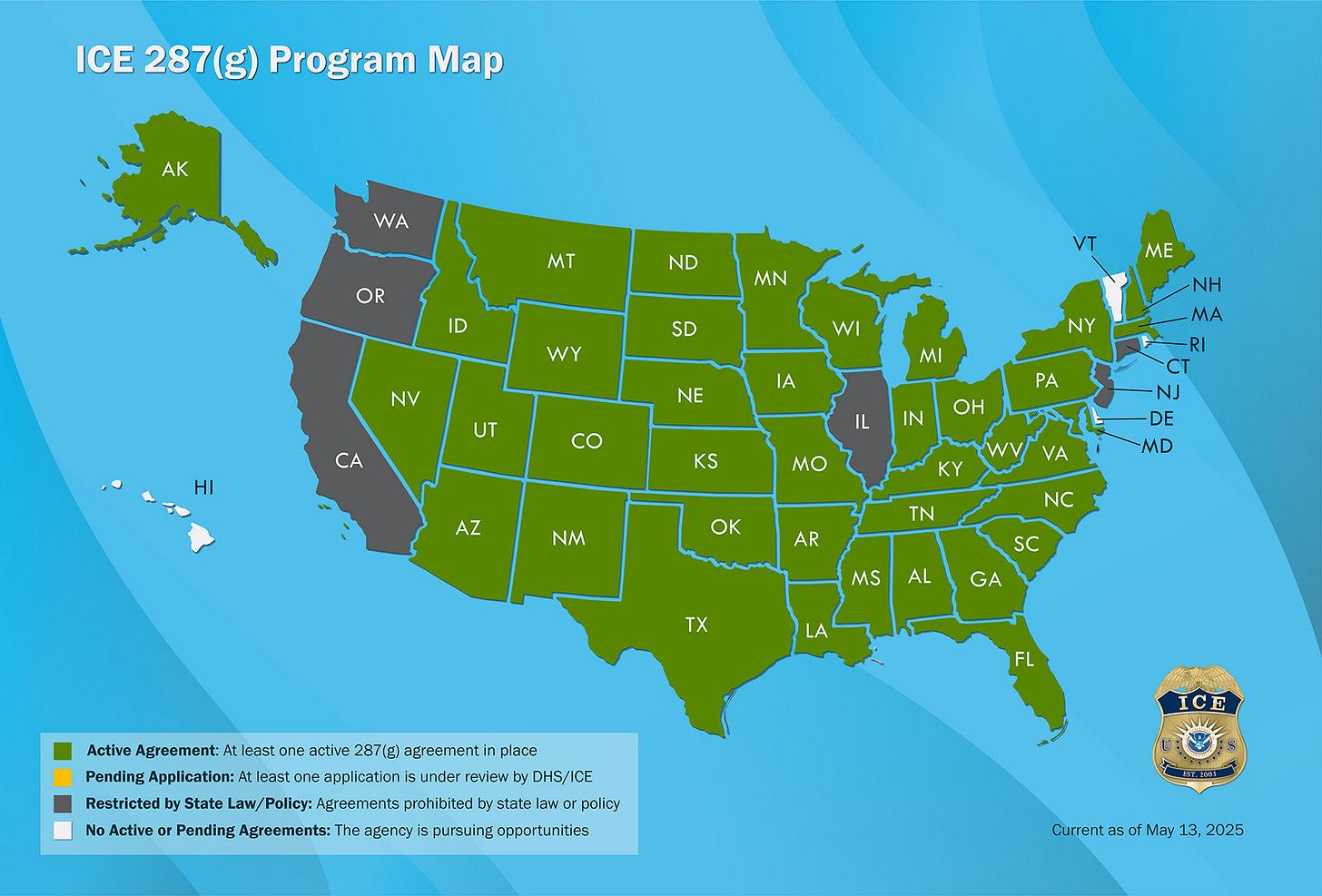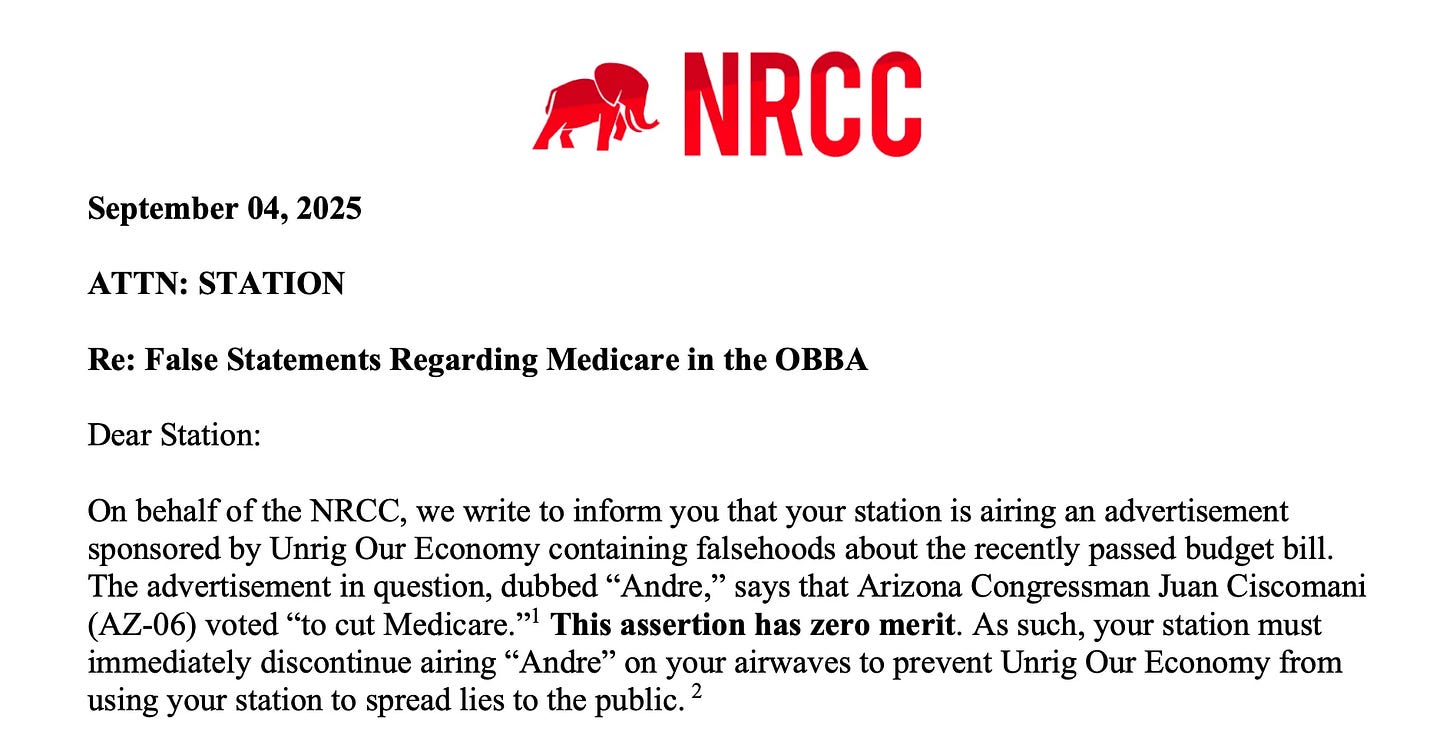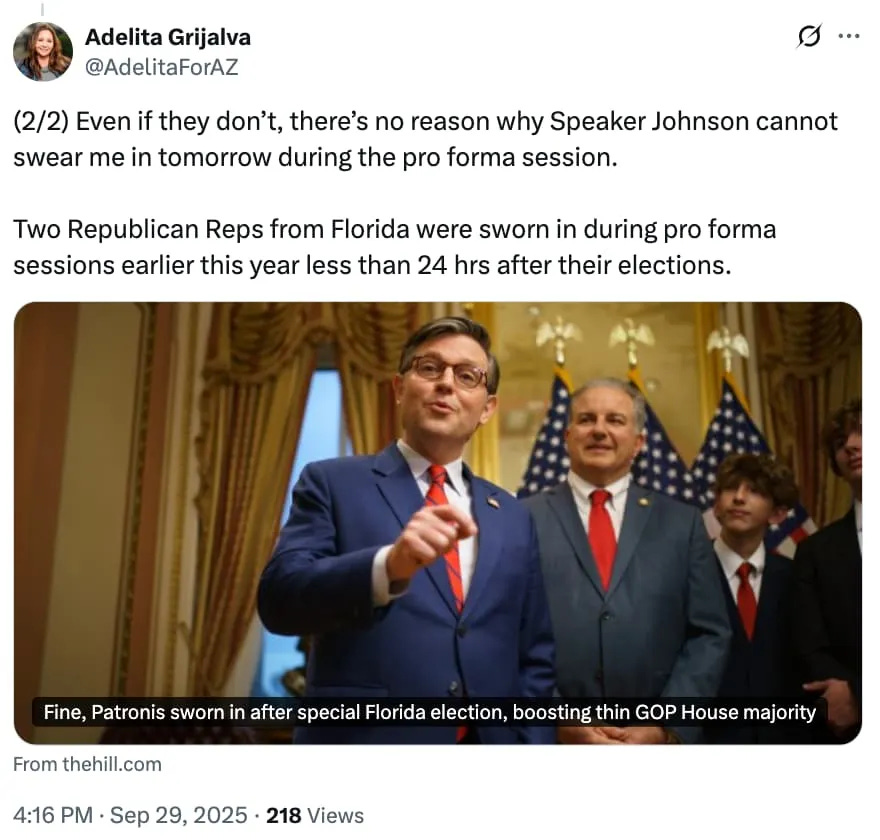Bread and Circuses, Tucson edition
The feds brought out their scissors … NRCC hates this one political ad … And a bear wasn’t on our bingo card.
Be nice to everyone working in government this week.
With a looming government shutdown and a very detailed analysis of how the “Big, Beautiful Bill” will impact the state out this week, there is little good news ahead for any public servant.
From Arizona Department of Public Safety officers to the people running SNAP, the long-term outlook is grim.
We all remember what happened last time there was a shutdown: the divide between “essential” and “non-essential” services and disruptions in paychecks and services. The Grand Canyon is always a good yardstick, but anyone who remembers the ”bloodless coup” staged by then-Gov. Fife Symington knows the feds make the final call — not the governor.
For those who don’t remember that story: During a federal shutdown back in the 90s, Symington showed up with 50 National Guard troops and two dozen state staffers to reopen the Canyon, but the feds shut it all down with a single piece of paper.
If the government shuts down and Gov. Katie Hobbs can’t keep Arizona’s largest ditch open, there’s little hope for places in Tucson, like Mount Lemmon and Saguaro National Park.
To be clear, the shutdown is still a big “if” — Congress is pretty good at skirting shutdowns. Almost like they know shutdowns are deeply unpopular with both Republicans and Democrats.
Eventually, Washington will reshuffle the deck chairs, and the government (and the parks) will reopen.
Southern Arizona’s whack-a-mole
We’ve spent most of this year trying to predict what DOJ rulings, executive orders, threatening letters from federal agencies, delayed checks, and court decisions will mean locally.
To be honest, it feels like an endless game of whack-a-mole — and it’s exhausting.
A 36-page memo out of Pima County Administrator Jan Lesher’s office last week — summarizing the “Big, Budget Bill” impact on Arizona, both right now and in the future — was a gut punch across the state. It comes from the state’s Joint Legislative Budget Committee, the nonpartisan experts on Arizona’s finances. There’s a second memo on the impacts of the possible shutdown here.
Whether you’re worried about kids who rely on SNAP for food or how we’ll keep Arizona highways safe, there isn’t much “good news” here.
And it’s still unclear exactly how this will play out for Pima County, the City of Tucson, or community nonprofits that rely on government funds. Once we know more, we’ll fill in the blanks in future editions of the Tucson Agenda.
The numbers
“Revenue adjustments” will cost the state nearly $440 million this fiscal year, according to JLBC. For example, increasing the state and local tax (SALT) deduction from $10,000 to $40,000 will cost Arizona an estimated $80 million.
Not familiar with SALT? It lets taxpayers deduct certain state and local taxes from their federal taxable income. And as you might guess, it won’t help the guy working at Arby’s nearly as much as high-income earners.
We’re also watching a tax credit for “Certain Non-Residential Production Property,” estimated to cost the state another $45.5 million this year.
SNAP cuts don’t hit until next summer (smack in the middle of the midterms), but they’ll shift more administrative costs to the state — about $33 million next year. And that’s not all: A new mandate designed to lower “error rates” to an arbitrary 6% will force the state to hire additional compliance officers, adding an estimated $59 million to the program.
At a time when federal dollars are declining, those extra costs almost certainly mean less funding for people who actually rely on SNAP.
Join the dark side (we have grants)
For law enforcement, there’s a come-to-Jesus moment ahead.
Pima County Sheriff Chris Nanos and the Tucson Police Department have refused to work with U.S. Immigration and Customs Enforcement (ICE) and have not signed 287(g) agreements, which require local law enforcement agencies to cooperate with ICE on immigration issues.
Locals here will remember the Stonegarden fight, which saw the end of a long-running grant agreement between Pima County and federal immigration agencies.
Well, the JLBC says agencies that opt out of similar agreements will be choosing to lose federal funding.
“We are unable to estimate the total reimbursements received by Arizona law enforcement agencies, as it will ultimately depend not only on the level of participation in 287(g) agreements, but also on how much of the $29.85 billion is available for state and local law enforcement,” the memo reads.
The memo lists the following Arizona law enforcement agencies with 287(g) agreements in place: Arizona Department of Corrections; Cochise, La Paz, Navajo, Pinal, Yavapai, and Yuma county sheriff’s offices; and the Mesa Police Department.
And don’t forget rural hospitals. The estimated loss of revenue to rural facilities from the Health Care Investment Fund is $2.1 billion a year in Arizona.
The “Big, Beautiful Bill” has set aside $50 billion nationwide over five years to go to the states, but it’s pretty clear not every hospital will be able to keep its doors open.
Did we miss another piece of the “Big, Beautiful Bill” cuts? Drop your thoughts in the comments.
Well, someone at the National Republican Congressional Committee was pissed.
Earlier this month, the NRCC pushed local NBC affiliate KVOA to take down a 30-second ad spot criticizing Tucson Congressman Juan Ciscomani for his support of the “One Big, Beautiful Bill” and how it will impact Medicare.
It’s that last part that has the NRCC upset about the ad paid for by “Unrig our Economy.”
“The advertisement in question, dubbed ‘Andre,’ says that Arizona Congressman Juan Ciscomani (AZ-06) voted ‘to cut Medicare.’ This assertion has zero merit. As such, your station must immediately discontinue airing ‘Andre’ on your airwaves to prevent Unrig Our Economy from using your station to spread lies to the public,” the group wrote to KVOA leadership.
Unrig Our Economy has been running ads critical of Ciscomani for months on a number of political issues locally.
Demanding an ad be pulled is a fairly common tactic during election cycles, usually with lawyers arguing the information inside the ad is misleading or lawsuit-worthy in some way.
We were told that the ad wasn’t pulled, despite the NRCC’s complaint.
One thing is certain: This isn’t the last takedown letter that will be sent in this political cycle. We still have 13 more months to go!
Digging out of a hole: Two years after University of Arizona officials announced a $177 million budget shortfall, the school is back in the black, the Arizona Republic’s Helen Rummel reports. UA officials didn’t track how many positions were cut to make ends meet, but the school’s workforce dashboard shows more than 600 positions were cut between 2023 and 2024. Faculty Senate chair Leila Hudson said those cuts are still being felt all over campus. The new financial health comes as the Trump administration is going after higher education, including $18 million in cuts to grants and contracts at the UA.
Still waiting: As of Monday afternoon, Congresswoman-elect Adelita Grijalva still didn’t know when she’ll be sworn in, the Tucson Sentinel’s Jim Nintzel reports. She spoke to Nintzel after flying to Washington, D.C., saying she heard House Speaker Mike Johnson might wait until the election has been legally canvassed in mid-October. Grijalva maintains that her announcement that she would release the Epstein files is the reason Johnson is dragging his feet. In the meantime, she can’t hire staff or open an office in Tucson or D.C. until she’s sworn in. But she’s planning to hire Marisol Flores-Aguirre, who was the director of Gov. Katie Hobbs’ Southern Arizona office, as her chief of staff.
Shift in focus: After years of helping people find housing, but not making a significant dent in local homelessness, Tucson and Pima County officials should stop thinking about the issue “as solving people’s difficult problems, and start thinking about the issue as primarily one of securing public spaces,” Arizona Daily Star columnist Tim Steller writes. He pointed to the recent killing of bicyclist Enrique Mercado on the Loop last week as another sign that officials need to focus on making public spaces like parks more usable for the general public.
Pickleball tariff: Oro Valley officials are looking at a “use tax” to bolster the town’s revenue, which is kind of like a local version of a tariff, Tucson Sentinel columnist Blake Morlock writes. They’re also looking at fees on adult recreation, like playing pickleball, which haven’t been raised in a decade. In other town business, they’re considering hiring a town attorney for the first time.
If it pickles your fancy, click that button.
If it’s not one thing, it’s another: The Project Blue developers are planning to cool the data centers with air, instead of water. That might alleviate some concerns about water usage, but it’s raising concerns about noise from chillers, cooling towers and other equipment, the Star’s Tony Davis reports. But Beale Infrastructure says the site of the data centers will be far enough away from residences not to disturb people.
Yogi Bear was an accomplished picnic basket thief who was hailed as “smarter than the average bear” for perpetuating his crime spree on the unsuspecting American public for decades.
But one local bear is thinking bigger.
Check out this video of a bear looting a whole Oro Valley grocery store.
Much like crime-bear Yogi, the suspect is still at large.
“According to Arizona Game & Fish, officers are currently out looking for it,” KVOA writes.









“Alleged” crime-bear Yogi. The case against him hasn’t been litigated yet and he hasn’t even been arraigned. You’re going to make jury selection really difficult with assumptions like this!
Regarding Steller’s column, I’m hoping that the recent tragedies involving interactions with unhoused/substance-affected people will shift the dialogue. To truly balance public safety with human dignity, we will need both services (perhaps housing, but mostly basic needs and designated encampments) and law enforcement (deterrents, including citation and incarceration, for camping, panhandling, etc, in public spaces), not one or the other. The tough reality for progressives to accept is that not all unhoused people are the same. Not all want housing according to the housed population’s (and policymakers’) paradigm. Some just purely want to be left alone, and may not be able to engage with resources and/or housing due to the nature of substance use or other untreated diagnoses. And those who want or need housing may not need SUD services; rather, they may have found themselves on the streets due in large part to cyclical financial woes/ poverty. I’m speaking from the perspective of a social worker and previous homeless outreach worker who engaged with chronically unhoused folks for years. It’s so hard to get someone in that situation to even consent to the process of getting housed, let alone stabilizing them in housing. Long story long, our local leadership would do all a service by balancing the approach between a Housing First resource model and a public safety model. I’d venture to guess that the collective could get behind that.